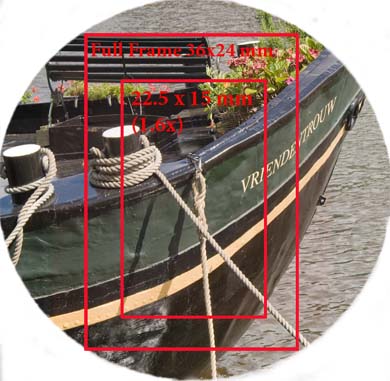|
|
The Crop Factor
A lens will always project a circular image onto the back of the camera, the recording media will capture the image as a smaller rectangle inside this circle. If the edges of the rectangle extends to the circumstance of the circle then the camera is considered to have captured full frame. This is the case for 35 mm cameras, but most digital sensors used in DSLRs cameras will capture a smaller rectangle as the sensors are smaller than 35 mm negative film. Thus the smaller sensor of the digital camera produces a reduced field of view.
 |
The crop factor is the diagonal of 35 mm film divided by diagonal of the sensor. The crop factor is also known as the Focal Length Multiplier (FLM) as when you multiple the focal length of the lens with the crop factor, you will give the equivalent focal length that you would need, to produce the same image on a full frame camera.
This crop factor means that the focal lengths marked on all lens will have to be multiplied the FLM for the sensor to get the field of view.
That is on a Canon 40D using a EF-S lens at 17 mm, the image taken will have the field of view as an image taken with a Canon 5D using a EF lens at 28 mm.
The actual focal length of the lens does not change, as this is determined by the physical construction of the lens optics. It is not true that you need a crop factor for all DSLRs as there are now many full frame DSLRs on the market, like the Canon 5D, and 1Ds ( The Canon ID has a crop factor of 1.3). |
Should the Photographer be concerned about the Crop Factor.
Should a photographer using a small sized sensor be concerned about the crop factor, well there are a number of points to remember,
- Depth of is actually greater when compared to the image that would have be produced by a lens of the equivalent focal length taken by a full frame camera. This is because real focal length of the lens does not change and is lens construction that effects the depth of field.
- Prospective, attaching a lens designed for full frame may caused the photographer to move further away from the subject, thus effecting prospective. But when the photographer does not move the prospective is unchanged.
- Camera shake, the old rule for camera shake is no longer valid, if your lens has a focal length of 50 mm, then under the camera shake rule you would need a shutter speed of faster than 1\50, to avoid camera shake for hand held cameras. But to avoid camera shake, the equivalent focal length needs to used and thus for 50 mm, the equivalent focal length is 50 x 1.6 = 80 mm, therefore you need a shutter speed faster than 1/80.
- For lens that are not designed for the smaller sensors, the crop will remove the soft edges produced by your lens as all lens are sharper in the center than at the edges.
- There are special lens that are produced for the smaller sensor, for canon the EF-S series are one such set of lenses. The lens are closer to the sensor than lens designed for Full Frame cameras and thus cannot be used on Full Frame Cameras. As these lens produce a smaller circle thus if they were used on a Full Frame camera you would see black edges around the image. Also as the end of the lens is closer to the sensor, there is a danger that the mirror will hit the lens on a Full Frame Camera.
|